“Damn the torpedoes, full speed ahead!”
21 August 2012
PARIS HORTON KEACH – BALTIMORE
![]() It is very gratifying and exciting when I start down a path and doors start opening. Yesterday I saw a gorgeous picture of Keach soda water bottles from Baltimore in a color run on facebook (Fig:1) that I quickly surmised as being torpedoes in form. You will also sometimes hear the term Ten-pin to describe the shape.
It is very gratifying and exciting when I start down a path and doors start opening. Yesterday I saw a gorgeous picture of Keach soda water bottles from Baltimore in a color run on facebook (Fig:1) that I quickly surmised as being torpedoes in form. You will also sometimes hear the term Ten-pin to describe the shape.
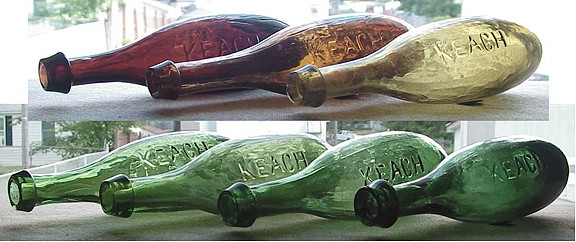
Fig: 1 Paris Horton Keach 1845-47 torpedoes. My color run is coming along nicely. Would really like an olive colored example or an aqua one – Chris Rowell
Torpedoes make me think of the phrase “Damn the torpedoes, full speed ahead!” This leads me on a quick search to brush-up on my history of Admiral Farragut who I believe the phrase is attributed to. I also seem to remember a United States postage stamp (Fig:2) from my stamp collecting days. Looking good so far; bottles, color run, history, postage stamps, Baltimore (my home town) etc. All the right ingredients!
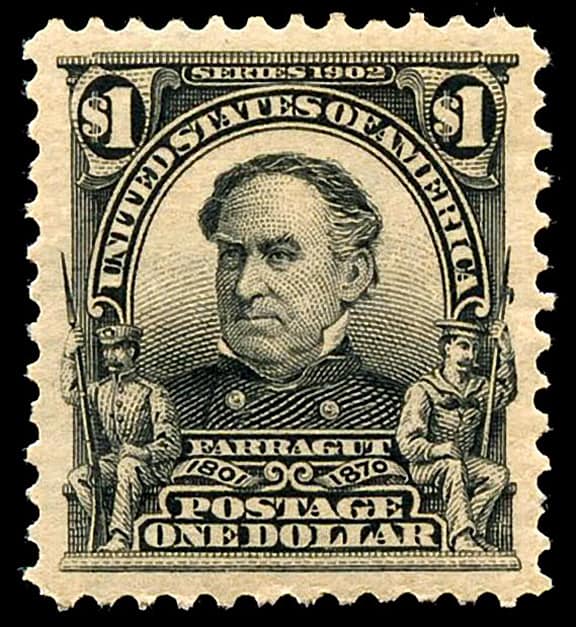
Fig: 2 U.S. Postage stamp, David Farragut, Issue of 1903, 1-dollar. black, U.S. Government, Department of the Post Office
I then circle back to Chris Rowell, the Baltimore digger and collector that posted the Keach torpedo picture. It seems like whenever I see a great torpedo soda, I think of Chris who specializes in this area (Fig:3). Visit Chris Rowell’s web site: Antique Bottles of Baltimore. Read more on Chris at PRG:
Some Early Hostetter’s Stomach Bitters Shards Dug by Chris Rowell,
E & S FREY, BALTIMORE Druggist’s Label Restoration by Chris Rowell
The Washington Monument Bottle – Baltimore
Well, let’s put a lasso around all this torpedo talk and get started. I really do not know that much about any of the various soda brand names that are embossed on torpedoes other than just recognizing a few of the popular Baltimore names (Fig:4) such as Keach, Boyd, Cole, Coughlan. Gardner & Brown and Russell. You can see examples on Chris’s web site.
First, a quick search confirms my memory and leads me to a wonderful illustration of Rear Admiral David G. Farragut found in Harpers Weekly (Fig:5). A definition from Wikipedia confirms the phrase is from the Battle of Mobile Bay in 1854 and attributed to the Admiral.
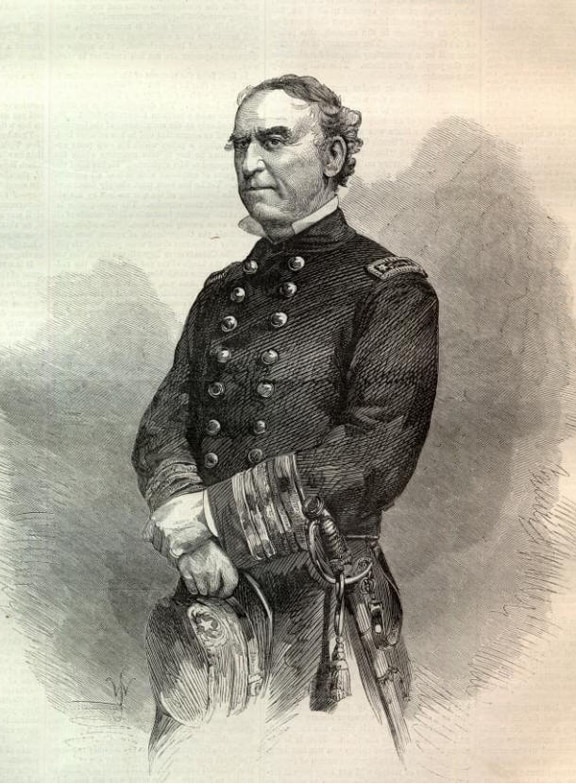
Fig: 5 Rear-Admiral David G. Farragut, U.S.N. illustrated in Harper’s Weekly, Saturday, August 29, 1863
[Wikipedia] David Glasgow Farragut (July 5, 1801 – August 14, 1870) was a flag officer of the United States Navy during the American Civil War. He was the first rear admiral, vice admiral, and admiral in the United States Navy. He is remembered in popular culture for his order at the Battle of Mobile Bay, usually paraphrased: “Damn the torpedoes, full speed ahead!” by U.S. Navy tradition.
The Battle of Mobile Bay (fig:6) of August 5, 1864, was an engagement of the American Civil War in which a Federal fleet commanded by Rear Adm. David G. Farragut, assisted by a contingent of soldiers, attacked a smaller Confederate fleet led by Adm. Franklin Buchanan and three forts that guarded the entrance to Mobile Bay. The battle was marked by Farragut’s seemingly rash but successful run through a minefield that had just claimed one of his ironclad monitors, enabling his fleet to get beyond the range of the shore-based guns. This was followed by a reduction of the Confederate fleet to a single vessel, ironclad CSS Tennessee. Tennessee did not then retire, but engaged the entire Northern fleet. The armor on Tennessee gave her an advantage that enabled her to inflict more injury than she received, but she could not overcome the imbalance in numbers.
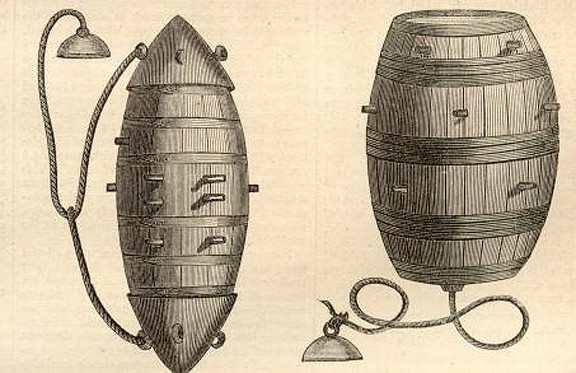
Fig: 7 60-lb. charge and 100-lb. charge Mushroom Anchor Torpedoes used by rebel Confederates in the seige of Mobile, Alabama
So now that I have torpedoes wrapped up in my mind, I start thinking of why these bottles are called torpedoes (Fig:7). Actually, I have always wondered why someone would even make a bottle in this shape which would be so hard to ship and sit upright on a table or bar. The torpedo pictured above is not the sleek, thin torpedo we think of from World War II movies but instead a bulbous, fat cigar shape very similar to the soda bottles. It is almost like the bottle designer was inspired by torpedoes! They were made early I understand. Here is some basic information that I could find on Keach in Baltimore.
[from Chris Rowell – Antique Bottles of Baltimore] I don’t have exact dates for when Keach was in business but I would say early 1840’s-1848. This is one of the more available Baltimore torpedoes and in my opinion this is not because Keach was in business for a long time but because Keach went out of business very suddenly leaving many empty bottles in the hands of consumers so many of those bottles ended up in attics, basements, and privies because there was no one to return them to. I know of only one Keach mold it is very distinct in that Keach is embossed high up on the torpedo and very close to one of the seams of the bottle rather than being centered like the other Baltimore torpedoes. This bottle also comes in a wide variety of colors including apple green, yellow green, deep emerald green, olive green, yellow topaz, and apricot puce. They are only found with a smooth base with a sharp tapered lip.
[Wil Martindale – the Bottle Den] Another early one, Paul (or Paris?) Keach went to a yellow green torpedo probably around 1845 through 1847 when he suddenly dropped out and his mold was used to create the RUSSELL torpedo (around 1847). The vast majority of whole KEACH’s are yellow green in color, and all known examples are in torpedo form.
These exotic yellows, deep clarets, topaz and apricot puces, I believe, pre-date 1845 and were blown right alongside SUTTON’S open pontiled deep puce soda, some looking from the same batch of glass, maybe a little later than the open pontiled deep claret lager it is next to in a couple pics (RANDALL era, late 30′s). I believe they finished these torpedos in a clamp between 1840 and 1845 at Federal Hill, whereas the open pontiled RANDALL (and a few other super rare open pontiled ones) pre-date 1841.
[from North American Soda and Beer Bottles] Something different happened in Baltimore. Whereas the Roussel style bottle was the norm in the rest of the country, in Baltimore some of the early producers used the Roussel style at first, and then shifted to the English style of torpedo or ten pin shaped bottles. In fact during the period 1845 to 1850, all of the soda bottles used by Baltimore merchants (with the exception of the extremely rare Cole & Co and Cole & Chickering sided sodas) were of the English style. There are at least two possible reasons for this: first, Baltimore was a port city where imported English style bottles were probably in most establishments. These could have been reused by some bottlers who may have had their own bottles made in the same style for constant filling and packaging. Second, this style of bottle was used by Randall & Company and John Lee Chapman, who were fashionable producers. Randall & Company were in the famous Barnum’s Hotel and Chapman operated a well known soda water shop and drug store. Perhaps this style of bottle represented a higher class of product. Whatever the reason, collectors can be thankful for these beautifully shaped and variously colored bottles.
It seems that more Baltimore bottles of these forms were dug in California than in Baltimore!
About 1851 Peter Babb moved his mineral water establishment from Philadelphia to Baltimore, and successfully reintroduced the soda shaped bottle to the Baltimore market. Soon all of the Baltimore firms were phasing out the torpedo and ten pin shaped bottles and using the soda shaped bottles. William Russell and William Coughlan are examples of this shifting of styles. But what to do with all of the old style torpedo and ten pin shaped bottles? Many were filled with soda and mineral waters, packed on ships and sent to the gold fields of California. It seems that more Baltimore bottles of these forms were dug in California than in Baltimore!
[from North American Soda and Beer Bottles] Randall & Company was a partnership that was made up of Dudley A. Randall and Paris Horton Keach. Both men were born in Rhode Island, but their lives were to follow different paths. Randall was born about 1806 and in 1826 we find that he was living in Providence, Rhode Island as a member of a fire company. Eliza Fenner and Dudley A. Randall were wed in Providence by Rev. Pickering on Oct. 28, 1829. By 1828, Randall is listed as a grocer. Grocers in New England often engaged in the brewing of small beers like mead and root beer. It appears that Randall learned this trade and became proficient enough in brewing, that he relocated to Baltimore between 1832 and 1835 and set up a mead manufactory at 126 Howard Street. He claimed that he had been in this occupation for 11 years in 1844, which may place him in Baltimore in 1833 or perhaps he was brewing in Providence starting in that year.
Keach was born about 1816. Keach married Eliza Niebling on November 21, 1843 at the First English Lutheran Church in Baltimore. It is possible that Keach was related in some way to Randall, but in any case the two were partners in Randall & Company starting as early as 1839.
KEACH BALT
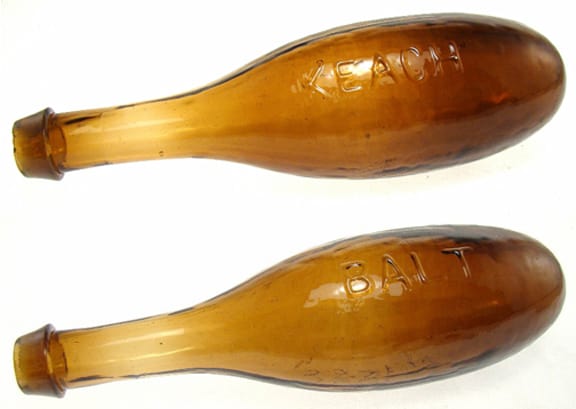
Apricot puce KEACH BALT Torpedo Soda Water – American Bottle Auctions (Sold for $8,000 without auction house premium) *a similar example in a holder sold for $17,920 (see top of this post for image)
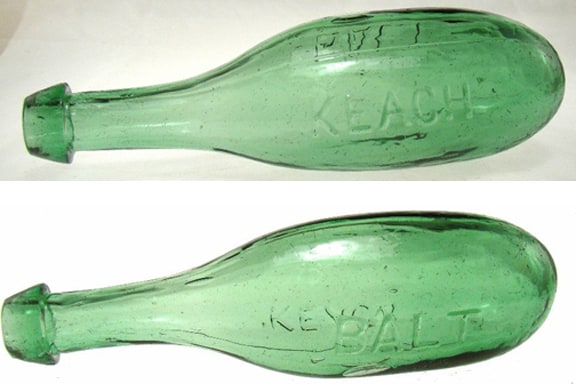
Green KEACH BALT Torpedo Soda Water – American Bottle Auctions (Sold for $1,300 without auction house premium)
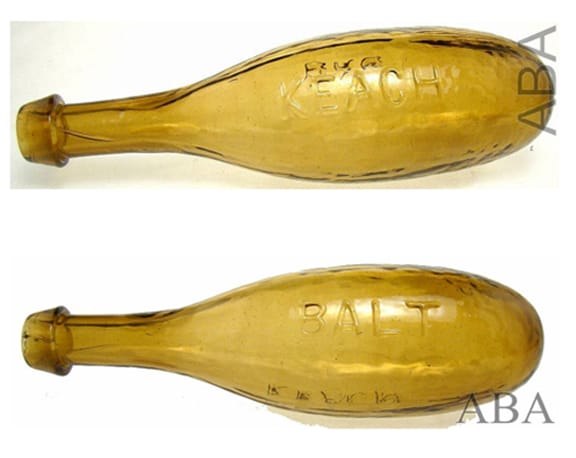
Apricot KEACH with BALT on reverse – American Bottle Auctions | Auction 53
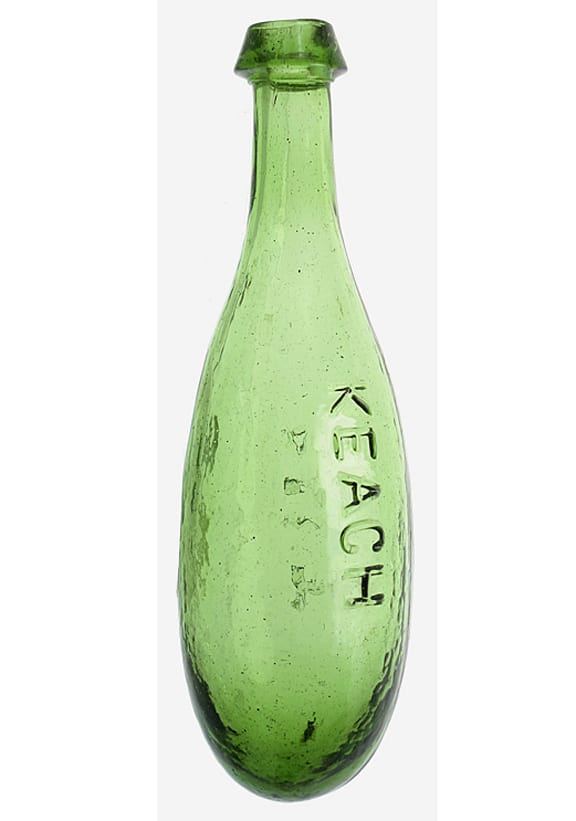
KEACH BALT in brilliant yellowish green, highly whittled, thousands of bubbles – GreatAntiqueBottles.com
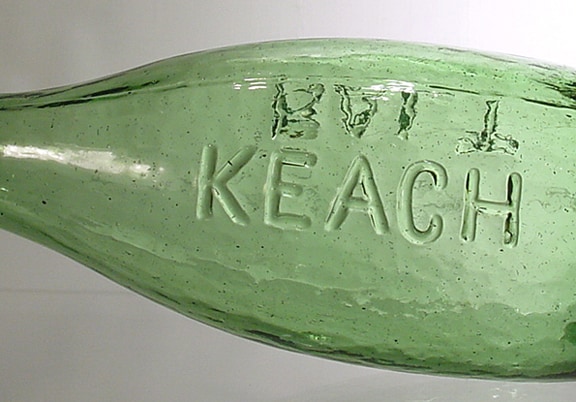
Detail of above, KEACH BALT in brilliant yellowish green, highly whittled, thousands of bubbles – GreatAntiqueBottles.com


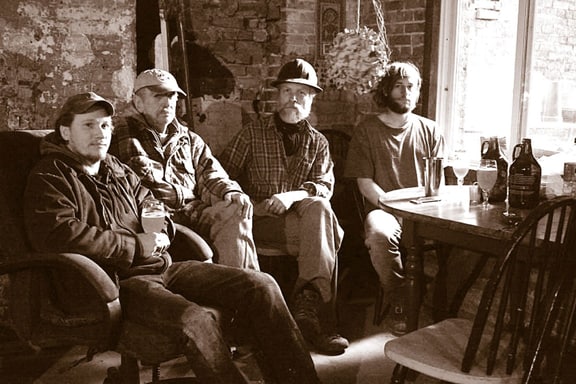
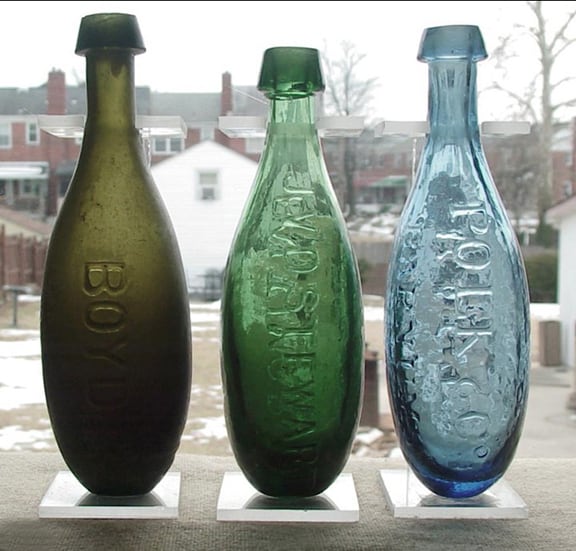
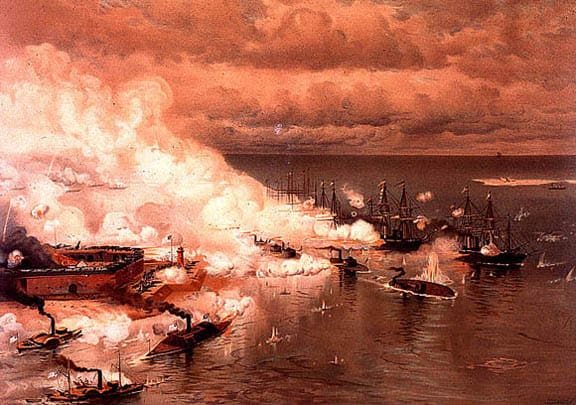








I knew nothing about this style of soda / mineral water bottle; what a terrific story! Fascinating to say the least!